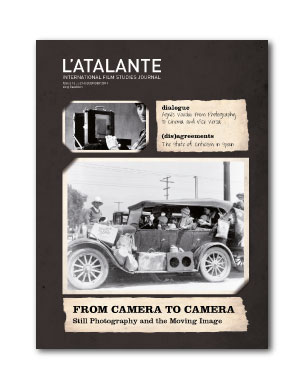Notebook
The Camera Lucida (and the Digital Camera): the Re-mediation of Photography in Computer Generated Animation.
Published 2011-07-01
Keywords
- Photography,
- re-mediation,
- computer generated animation,
- digital image,
- advertising
How to Cite
Martín Núñez, M. (2011). The Camera Lucida (and the Digital Camera): the Re-mediation of Photography in Computer Generated Animation. L’Atalante. Journal of Film Studies, (12), 48–53. https://doi.org/10.63700/74
Abstract
Through a rereading of Barthes' Camera Lucida, this essay analyses the values of the photographic image present in the digital image. The notions of objectivity, truth, manipulation, temporality and certificate of presence that are unique to photography are re-mediated (adopting Bolter and Grusin’s terminology) in the photorealist style of computer generated animation. The digital image is therefore conceived of as a hyperimage, capable of integrating other earlier means of representation and reproducing the values they conveyed. The analysis of the photorealist elements in Coca-Cola's advertisement Happiness Factory supports the theoretical argument developed in the article.Downloads
Download data is not yet available.
References
BARTHES, Roland (1989). La cámara lúcida. Nota sobre la fotografía. Barcelona: Paidós Comunicación.
BAZIN, André (2001). ¿Qué es el cine? Madrid: Rialp.
BOLTER, Jay David y GRUSIN, Richard (1999). Remediation. Understanding New Media. Cambridge, Massachussetts y Londres: MIT Press.
CATALÀ DOMÉNECH, Josep M. (2005). La imagen compleja: la fenomenología de las imágenes en la era de la cultura visual. Bellaterra: Universitat Autònoma de Barcelona, Servei de Publicacions.
FERNÁNDEZ CASADO, José Luis y Nohales Escribano, Tirso (1999). Postproducción digital. Cine y video no lineal. Adoain: Escuela de cine y video.
FONTCUBERTA, Joan (1997). El beso de Judas. Fotografía y verdad. Barcelona: Gustavo Gili.
GÓMEZ ISLA, José (2004). Determinismo tecnológico y creación contemporánea. En MURO MUNILLA, Miguel Ángel (coord.), Arte y Nuevas tecnologías: X Congreso de la Asociación Española de Semiótica (pp. 538-549). La Rioja: Fundación San Millán de la Cogolla y Universidad de La Rioja.
GUBERN, Román (2003). Del bisonte a la realidad virtual. La escena y el laberinto. Barcelona: Anagrama.
LISTER, Martin (1997). Ensayo introductorio. En LISTER, Martin (comp.), La imagen fotográfica en la cultura digital. Barcelona: Paidós.
MARTÍN NÚÑEZ, Marta (2009). La (re)construcción de la (hiper)realidad: usos de la animación infográfica en el espot publicitario en el contexto de la hibridación de medios. Tesis doctoral. Castellón: Universitat Jaume I. (Publicación en línea, URL [http://hdl.handle.net/10803/10397] Consulta: 17 octubre 2010.)
MARZAL FELICI, Javier (2007). Cómo se lee una fotografía. Madrid: Cátedra.
MITCHELL, William J. (1992). The Reconfigured Eye. Visual Truth in the Post-photographic Era. Cambridge, Massachusetts y Londres: The MIT Press.
ROBINS, Kevin (1997). ¿Nos seguirá conmoviendo una fotografía? En LISTER, Martin (comp.), La imagen fotográfica en la cultura digital. Barcelona: Paidós.
BAZIN, André (2001). ¿Qué es el cine? Madrid: Rialp.
BOLTER, Jay David y GRUSIN, Richard (1999). Remediation. Understanding New Media. Cambridge, Massachussetts y Londres: MIT Press.
CATALÀ DOMÉNECH, Josep M. (2005). La imagen compleja: la fenomenología de las imágenes en la era de la cultura visual. Bellaterra: Universitat Autònoma de Barcelona, Servei de Publicacions.
FERNÁNDEZ CASADO, José Luis y Nohales Escribano, Tirso (1999). Postproducción digital. Cine y video no lineal. Adoain: Escuela de cine y video.
FONTCUBERTA, Joan (1997). El beso de Judas. Fotografía y verdad. Barcelona: Gustavo Gili.
GÓMEZ ISLA, José (2004). Determinismo tecnológico y creación contemporánea. En MURO MUNILLA, Miguel Ángel (coord.), Arte y Nuevas tecnologías: X Congreso de la Asociación Española de Semiótica (pp. 538-549). La Rioja: Fundación San Millán de la Cogolla y Universidad de La Rioja.
GUBERN, Román (2003). Del bisonte a la realidad virtual. La escena y el laberinto. Barcelona: Anagrama.
LISTER, Martin (1997). Ensayo introductorio. En LISTER, Martin (comp.), La imagen fotográfica en la cultura digital. Barcelona: Paidós.
MARTÍN NÚÑEZ, Marta (2009). La (re)construcción de la (hiper)realidad: usos de la animación infográfica en el espot publicitario en el contexto de la hibridación de medios. Tesis doctoral. Castellón: Universitat Jaume I. (Publicación en línea, URL [http://hdl.handle.net/10803/10397] Consulta: 17 octubre 2010.)
MARZAL FELICI, Javier (2007). Cómo se lee una fotografía. Madrid: Cátedra.
MITCHELL, William J. (1992). The Reconfigured Eye. Visual Truth in the Post-photographic Era. Cambridge, Massachusetts y Londres: The MIT Press.
ROBINS, Kevin (1997). ¿Nos seguirá conmoviendo una fotografía? En LISTER, Martin (comp.), La imagen fotográfica en la cultura digital. Barcelona: Paidós.

